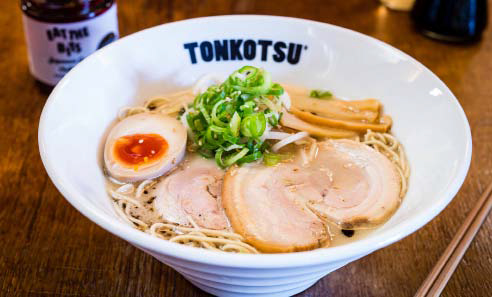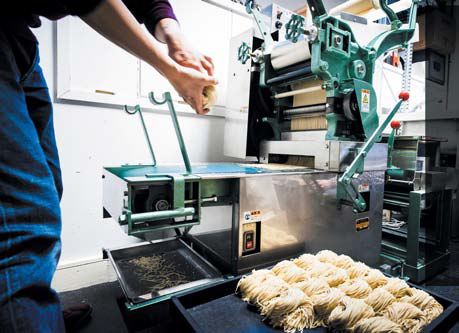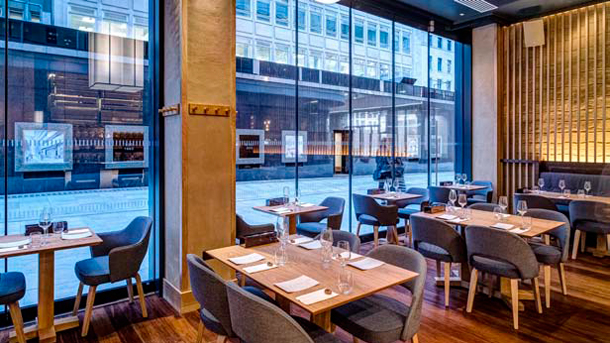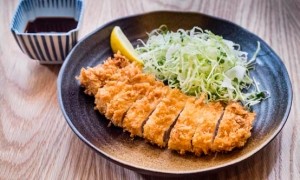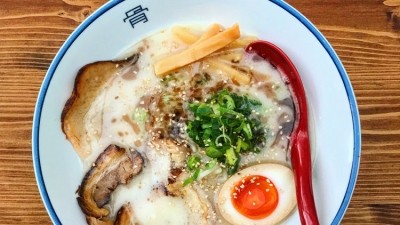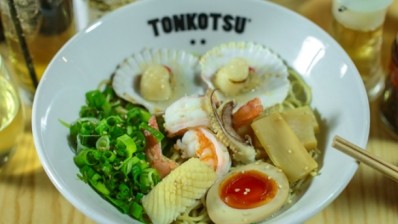Ramen revolutionaries
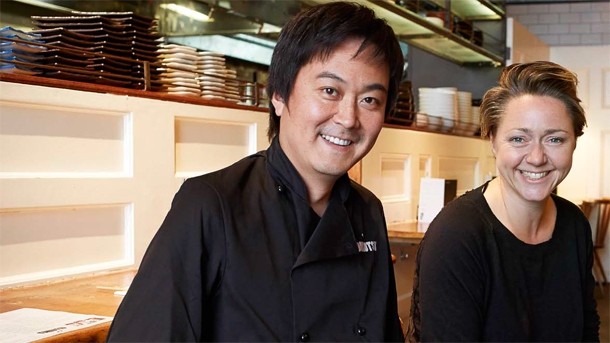
What have microbiology and noodles got in common? The answer is not the punchline to a joke from a cheap Christmas cracker, but rather Emma Reynolds.
Reynolds, the co-founder of ramen restaurant brand Tonkotsu, sushi and katsu curry bar Tsuru, and Anzu, the upmarket Japanese restaurant that recently launched in the newly opened St James’s Market in London, has worked in restaurants from the age of 16. She knew she wanted her career to be in the industry, but she also wanted to do “a proper degree” first. So, microbiology it was: “It was really interesting, but I have not really used it since,” she admits. “I still read the New Scientist every week though.”
A working knowledge of microscopic organisms might not be the most useful for running a restaurant on a day-to-day basis but it has given Reynolds an eye for the minutiae and made her more analytical. These attributes that have helped in her quest to make Japanese food more accessible to UK consumers.
This crusade hasn’t been undertaken alone. Reynolds has a vital ally in her friend, one-time flatmate, and now long-term business partner Ken Yamada, whom she met 12 years ago when she moved to London. At the time, Reynolds was working for Jollof Pot, a Londonbased catering company specialising in modern Ghanaian food and her and Yamada, who came from a chef background and whose parents worked in hospitality in his native Japan, decided to do something themselves.
The pair discussed plans for their own restaurant and when they got together with another friend, barrister John Zimmern (still involved on the financial side and on the board, but now as a silent partner), they started drilling down to discover exactly what their niche could be.
“I spent a lot of time in the British Library doing market research,” recalls Reynolds. “Asian food, then more specifically Japanese food, made sense, not just because of Ken’s experience but also because all the studies showed it was the fastest-growing food category in the UK. There were Japanese restaurants but they were not very accessible because they were either very high end or, if you took it down to fast-casual, they were very much for Japanese people.”
The trio refined their idea to create convenient Japanese food made from scratch and raised the money themselves to create Tsuru, a fast-casual restaurant that specialised in handmade sushi, katsu curry and ramen, opening their first site on Canvey Street, behind London’s Tate Modern, in 2007.
It was successful enough to allow them to open two more in the City, in Bishopsgate and Mansion House, but, faced with higher food costs than some of its rivals and strong competition in the sector, the brand never really took off. “At that time, itsu came along and commoditised the lunchtime sushi market,” she says. “Now you can get sushi in supermarkets too. We were a bit more expensive and we soon recognised that Tsuru was not really expandable.”
Using their noodle
Undeterred, Reynolds and her co-founders talked about other opportunities in the Japanese dining market and realised that no one in the UK was really focusing on ramen at the time. “It was crazy really, because a quarter of all meals eaten out of the home in Japan are ramen. It is cheap, easy, quick and nourishing.”
Indeed, Ramen is one of Japan’s best-known dishes and is eaten throughout the country. Reynolds and Yamada say that there are more than 34,000 ramen shops in Japan, with 4,000 in Tokyo alone – the dish even has a museum dedicated to it.
To test out their hunch that they could do something scalable based on noodles, Reynolds and Yamada spent several Friday evenings in their flat taking delivery of 50 kilos of pork bones and boiling them up for hours to attempt to replicate the highly-prized stocks found across Japan (while drinking beer, she adds). They also did a series of 10 Saturday pop-up events at Tsuru, advertising to their existing customers via their website and Twitter. Tickets were £10 for a bowl of noodles and a bottle of Japanese beer and the first event, for 30 people, sold out in five minutes. For the final event they sold 120 tickets (Reynolds says if they had the resources they could have sold many more) and served ramen and beer from 5pm and stayed partying with their customers until 2am.
Based on the success of these trials, the company put together a business plan for their ramen-based concept in 2012. The following year they secured a prime site on Dean Street in Soho that had been rejected by the larger operators because of its three-floor configuration, and thus Tonkotsu was born.
Success was instant, with customers queuing to get in from the get-go to lap up Tonkotsu’s much revered 16-hour pork broth (a process that allows the collagen to be emulsified into the stock) that is enriched with lardo and sea salt to create a full mouthfeel. As its website states: “Anyone who has eaten good ramen, made their own or even just seen the cult foodie film Tampopo, will know the importance of making a soup stock with perfectly balanced intensity.”
Reynolds’, and indeed Yamada’s eye for detail meant that their forensic approach to ramen stock wasn’t enough and they turned their attention to the other vital part of ramen – the noodles. Shortly after opening Tonkotsu, Yamada met a chef in Japan who had been making ramen for 50 years who said ‘if you don’t make your own noodles, you’re just a soup shop’. So the pair decided to serve home-made noodles at the site, something that turned out to be anything but straightforward.
First Yamada and Reynolds flew to Japan to a noodle machine factory, based in Tokyo. Acknowledging that there was an absence of noodle machine mechanics in London they opted for a relatively low-tech machine, the delivery of which took six months. During this time, Yamada worked on the noodle recipe but quickly discovered that he couldn’t find the right flour to give the noodles the required ‘bite’. “It’s easy in Japan because the Japanese – with their typical obsession to detail – have developed hundreds of different types of ramen noodle flour so it’s a matter of finding the one that will give your noodles the right characteristics. Here in the UK, it’s a different story as we have none of these flours,” he says.
Yamada searched for flour that, on paper, had a similar protein content to ramen flour and, after many failed attempts, finally discovered one from a specialist mill in Oxford that worked. He then turned his attention to the water. “To make ramen noodles with the right elasticity, the water needs to be soft and alkaline – our water in London is basically the opposite,” he says. “So an industrial filter and alkaline salts were called in and voila, we present you with what we believe are the finest ramen noodles you’ll find in London.”
Others shared this belief. In October that year, the restaurant won the Observer Food Monthly Award for Best Cheap Eats and its popularity continued to soar. Tonkotsu East, in Dunston Street, Hackney, soon followed, and then another restaurant slightly further east on Mare Street. The larger footprint of these sites allowed the pair to develop Tonkotsu’s range of drinks, especially Japanese beers, and gave them flexibility. The Mare Street restaurant, for example, has an extensive range of Japanese whiskies, and Tonkotsu is working on a number of collaborations for guest ramen dishes with various well-known chefs.
Tonkotsu also boosted its fast-casual credentials with the taking of a spot within the food hall at Selfridges. The 15-seat counter site is, per seat, the group’s busiest although Soho, being larger, has more sales, averaging more than £20,000 a week. Selfridges also helped give birth to the first non-London Tonkotsu when it opened a second counter at the department store’s Birmingham location in September.
Reynolds and Yamada now operate seven Tonkotsu and two Tsuru restaurants following the conversion of the original Tsuru site into a Tonkotsu. While there are no plans to change the remaining two, the focus for expansion is very much on Tonkotsu.
This hasn’t meant that the pair’s complete gaze is on building the ramen brand. In November, the group opened its first more premium restaurant, Anzu, at St James’s Market. Dubbed a Japanese brasserie, Anzu’s speciality is teishoku – a set menu of rice, pickles, salad, miso and a choice of main dish, including chilli miso lamb cutlets, katsu curry and teriyaki chicken or salmon.
It isn’t a roll-out brand, but rather an outlet for Yamada’s creativity that allows him to play around with more expensive ingredients. Wagyu fillet tataki carpaccio, for example, is £18 on the starter menu, which is almost double the price of any dish served at Tonkotsu, while its most expensive item is its seabass, cod, Madagascan prawn and hispi cabbage katsu at £24. Anzu also serves a more opulent version of ramen that features king prawn, squid and seabass, accompanied by a higher price tag.
The Broth brand
With an annual turnover of £6m, 75 per cent of which comes from food sales, and employing 120 people, the group has come a long way but has much more in the tank. To help Tonkotsu achieve its potential, the group has been busy getting its internal structure right and last summer appointed Stephen Evans, former development director of Gourmet Burger Kitchen, as operations director. He has since taken on the mantle of managing director, pressing ahead with initiatives such as the successful introduction of the UberEATS delivery service to three of the sites. Other recent appointments, mainly internal promotions, have been an operations manager, a head of drinks and an executive chef. The company is also close to appointing its first finance director.
“It is all very grown up,” Reynolds laughs. “We didn’t start out thinking we would have x-number of restaurants in so many years, we just said ‘we’ll see how it goes’. It has helped us grow in a good way and to recruit the right kind of people and develop a loyal customer base. But we can’t go to the next phase with that attitude. We need structure with focus and targets.”
These targets include a rebranding exercise for the group in the first quarter of the year that will give it a more consistent image while conveying Tonkotsu as an accessible but not too mainstream brand. “We don’t want to over brand it and lose the independent feel,” she says.
The aim is then to open a further three Tonkotsus by the end of 2017, with south London a target. It is likely all three will be within the capital “unless something amazing comes up” but in 2018, when the new head office team is bedded down, the group will more actively seek other locations, ideally within an hour of London, in urban centres such as Brighton and Cambridge.
The Tonkotsu model has proven to work in unusual configurations from the long thin counter with 20 seats at Notting Hill to the three-storey Soho branch, meaning that the company is more flexible with its site selection than others. That said, the ideal Tonkotsu would be a 50 to 60-cover restaurant. It takes about £250,000, excluding the premium, to get a site up and running and Reynolds says payback is comfortably within the magic three-year period favoured by investors.
The business has some debt funding to realise its ambitions for early next year, after which it hopes to be self-funding. Casual conversations are under way with interested parties with regards to external funding, which Reynolds anticipates will turn much more serious as the year progresses.
Right from the beginning, Reynolds’ and Yamada’s philosophy has been to create restaurants in which they would like to eat with good quality, reasonably priced food. It’s not rocket science. It’s not microbiology either.
